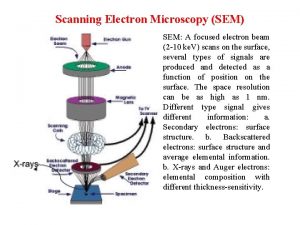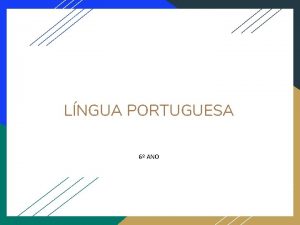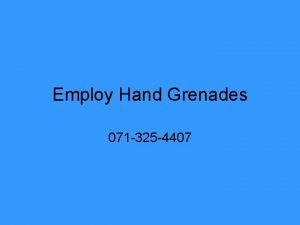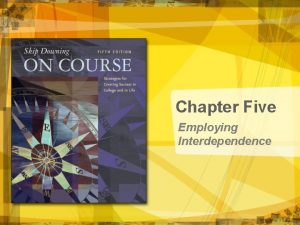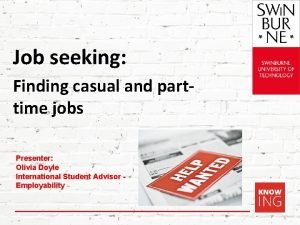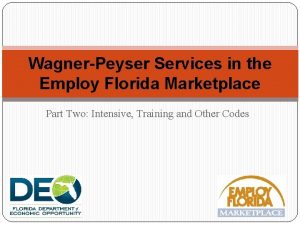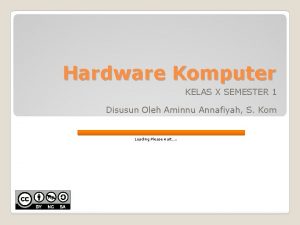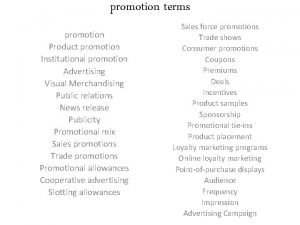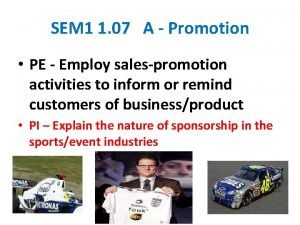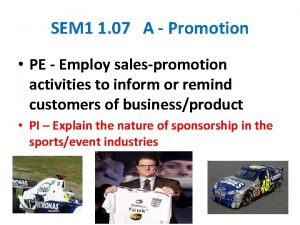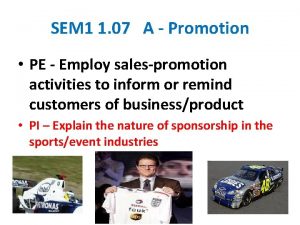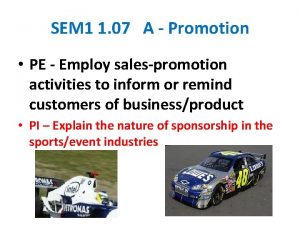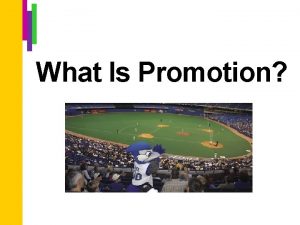SEM 1 1 07 A Promotion PE Employ





















- Slides: 21

SEM 1 1. 07 A - Promotion • PE - Employ sales-promotion activities to inform or remind customers of business/product • PI – Explain the nature of sponsorship in the sports/event industries

Why learn about sponsorships A. Sponsorship is one of the fastest growing promotional activities today 1. Nearly $20 billion dollars is spent on it globally each year. 2. People are passionate about the sports that they follow. a. Sports may provide them with an escape from the pressures of life. b. People are able to let their guard down. c. They are more receptive to the company names that appear on banners, stadiums, cars, uniforms, equipment, and promotional materials. B. So why not just pick any sport/event, pay the sponsorship fee, hang up some signs, and call it a day? 1. To achieve your marketing goals, there is so much more to learn about sponsorship. 2. Examples: a. How to pick a sport/event that will properly reflect your company’s image b. How to exploit the sponsorship so that people will buy your products 3. There also risks, some of them unique to sponsorship, that you should be aware of in order to protect your financial investment.

Why learn about sponsorships C. Even if you’re not ready to play the sponsorship game just yet, you should know something about sponsorship. 1. Sponsorship drives the sport/event industries. 2. Around 70 percent of pro-sports teams are sponsored in some form or another. 3. These teams might not be able to survive if it weren’t for the financial support given by the sponsoring companies. a. This may also be true of your favorite individual athlete or the team that your younger relative plays on. b. Even your high-school athletic program could be affected without the benefit of the new scoreboard that was paid for by local companies. 4. Sponsorship makes things that you might have never dreamed about possible.

Sponsorship A. It is a promotional tool capable of making lasting, emotional connections with spectators. B. Sponsorship is defined as the act of providing financial or other support to a sport/event entity in exchange for public exposure C. Example 1. The top-three teams of the two-day competition each receive a shiny trophy. All of the team players, regardless of ranking, receive a free T-shirt, all compliments of the bank. Proud parents are given a pennant to cheer their child on, and then later they can turn it in to the bank for a free box of checks upon opening a new account. The bank’s web address and a special promotional code are listed on the banners prominently displayed on the sidelines. People who type the word Soccer under the promotional code on the bank’s web page can sign up to receive free Internet banking for a year. By integrating the sponsorship into its other promotional activities, Community Bank is hoping its investment will turn into future profits.

Sponsors are available to all businesses everywhere A. Small businesses typically sponsor athletes, teams, leagues, and stadiums within local and regional communities. B. Large corporations tend to focus their sponsorship efforts on sport entities with national and/or international audience C. This approach makes sense because the businesses want to reach the people who typically buy their products. D. Example: Mountain Dew is the title sponsor of the “Dew Action Sports Tour” designed to increase its visibility with the extreme-sports market. E. Smaller businesses simply do not have the budget that larger ones do to spend on sponsorships.

Why businesses invest in sponsorships? A. To create brand awareness NASCAR sponsorships have a proven track record of creating brand awareness. 1. More than 70 percent of fans surveyed indicated a willingness to patronize the sponsors. 2. Reasons: a. To continue the sponsor’s financial support to NASCAR. b. To get the increased media coverage that results from the sponsorship, allowing fans to enjoy NASCAR racing in front of the television at home. 3. More than a billion dollars is spent on motor sports sponsorship every year.

Why businesses invest in sponsorships? B. Sponsorship also provides an opportunity to engage in business-to-business marketing. 1. Example: The lavish tents surrounding the golf course at the PGA Tournament 2. For fees ranging anywhere from $165, 000 to more than $300, 000, a sponsor can rent a tent filled with elaborate spreads of food, fine beverages, elegant furnishings, decorations, airconditioning, Internet access, and a spectacular view of the game.

Exclusive sponsorship rights A. Purchased when businesses don’t want to share the public exposure B. This arrangement is known as exclusivity. 1. Often involves a larger financial commitment on the part of the sponsoring company, but there are big payoffs. 2. For one, the sponsor usually has the sole rights to any merchandising and/or marketing activities within a specific category. 3. Example: Perhaps Coca-Cola is an exclusive sponsor of your favorite rock group in the category of carbonated beverages. If so, you won’t be able to buy a Diet Pepsi during intermission. Yet, if you’re thirsty for water instead, you might be able to buy an Aquafina, which is part of the Pepsi-Cola brand. To keep this from happening, Coca-Cola might purchase exclusivity rights for all beverage categories, including soft drinks, sport drinks, tea drinks, and water.

How are sponsorship relationships formed? A. The business contacts the sport/event entity. 1. The business may have a particular sport/event entity in mind that is aligned with its brand image. 2. The business makes an offer to provide support in exchange for certain sponsorship privileges. 3. Example: A business contacts the coordinator of the local downhill skiing race about supplying equipment in exchange for sponsorship privileges. B. The sport/event entity contacts the business to submit a sponsorship proposal to the business. 1. Large corporations receive hundreds of sponsorship proposals each year. 2. They often won’t even look at a proposal unless it follows specific guidelines. a. Example: Kodak requires detailed information about the sponsorship, sponsorship costs, marketing opportunities at the event, list of committed sponsors, expected attendance at the event, and audience demographics. b. This information helps Kodak determine if the sponsorship will be a good investment.

Terms of the sponsorship A. If the terms of a sponsorship proposal are not acceptable, the business may try to negotiate with the sport/event entity. 1. Example: Rather than paying a single, up-front sponsorship fee of $12, 000, the business may agree to pay three equal payments of $4, 000. B. Payments and other sponsorship terms are written in a formal contract, a letter of agreement, or a confirmation letter. 1. A contract is the most desirable because it is legally binding, and it is often used for sponsorships involving more than $20, 000. a. Example: When Reebok agreed to give Venus Williams $40 million to market tennis products, a contract was involved. 2. A letter of agreement is more commonly used for smaller investments, requiring the signature of both the sponsor and a representative of the sport/event entity. 3. A confirmation letter is not recommended because it does not provide solid legal backing in case of a dispute C. Need to be acceptable to both parties

What’s in it for sponsors? A. Sponsorship designations and resulting benefits vary from event to event. B. Example: At a skateboarding tournament, gold sponsors might receive 40 free tickets to the event, a full-page ad in the sport bulletin, and their name and logo on all promotional materials—all for the price of $5, 000. Silver sponsors might pay $3, 000 for 25 free tickets, a halfpage ad in the sport bulletin, and mention in all promotional materials. Bronze sponsors might receive even fewer benefits, but they also pay fewer costs. C. A different event might designate its top sponsors as corporate partners. 1. The term partners is frequently used to describe the relationship between a sponsor and a sport/event entity. 2. The two are basically a brand extension of each other. http: //youtu. be/pn 9 d. GKEf. IOA

Sponsorship Issues A. Goals of the sponsorship 1. The most basic question of any sponsorship: “What does the business hope to achieve? ” 2. The answer is likely to have something to do with sales, especially in terms of keeping existing customers or gaining new ones. 3. The goal of sponsoring Extreme Games (X-Games) might be to reach male members of Generation X. A youthful market with large disposable income to spend on leisure products 4. Businesses may decide to be sponsors when they find out about a competitor’s involvement. a. How might a printing company that refused to sponsor Race for the Cure, a fundraising event for breast cancer research, be affected when a competitor prints the informational flyers instead? b. The goal of sponsorship in this case might simply be to keep up with the competition. 5. Attracting media attention is another possible goal of sponsorship. a. Nearly 40 billion people worldwide see the billboards strategically positioned just off the World Cup playing field. b. On a smaller scale, an annual marathon held in a metropolitan city might not even be televised. However, a marathon sponsor could be mentioned on the evening news, which is viewed by several hundred thousand people.

Sponsorship Issues B. Reasons for selecting a sport/event entity 1. Sport/Event entity could be: athlete, team, league, event 2. Range/Scope of sport/event entity: local, regional , national or international 3. Competitive level of sport entity: recreational, High school, Collegiate, Amateur, Professional 4. Examples: a. A Little League team competes locally at the recreational level. b. The Orange Bowl is a national event played at the collegiate level.

Sponsorship Issues 5. Could create an entirely new sport/event entity a. Sometimes, this is referred to as “owning an event. ” b. Example: 1'. VANS created its Triple Crown Series to build awareness of its skateboarding, snowboarding, motor-cross, surfing, and other extreme-sports products. This allows VANS to maintain more control over all marketing activities during each event. The company can wisely choose cosponsors that share similar dedication to building extreme sports. 6. Should reflect the interests of the business’s target market rather than the business owner’s personal preferences 7. Examples: a. Anheuser-Busch invests more than $200 million in sponsorship every year. Much of it is devoted to football and motor racing because the fans like to drink beer more than wine. b. Audi, an upscale automobile manufacturer, sponsors sailing and equestrian events to reach affluent patrons that follow these sports.

Sponsorship Issues C. Sponsorship Risk 1. Ambush marketing a. Occurs when a business tries to associate with an event in order to gain recognition as a sponsor, even though it is not. b. This kind of behavior, although highly controversial, is perfectly legal and quite common because it typically works. c. Can take on many different forms d. Example: During the Olympic Games, Nike held press conferences featuring the highprofile athletes whom it endorsed. Of course, the Nike logo was visibly present, and many people incorrectly assumed that Nike was a sponsor. e. Another ambush tactic is purchasing large amounts of commercial time before or during an event. 1'. Gives the impression that the business is an official sponsor g. The attempt to gain worldwide exposure with a minimal financial investment is a major reason why ambush marketers target the Olympics. 2. Sponsorship clutter a. As with other types of advertising, too many sponsors can spoil it for the whole group. b. A single event might have 15 or more sponsors, all sporting banners at the venue. c. Consequently, fans might tune the clutter out.

Sponsorship Issues 3. Guilt by association a. Examples: 1'. What if a riot breaks out at an event? 2'. What if a sponsored athlete demonstrates poor sportsmanship, or even worse, gets arrested for a criminal activity? b. These behaviors are most certain to reflect poorly upon the sponsor’s image. c. The problem is that it can be difficult to predict exactly when, or if, the bad behaviors will happen. 4. Strikes a. Sponsors of Major League Baseball fell victim to the large salaries demanded by high-profile players. b. The sponsors lost valuable public exposure when the players went on strike and the scheduled games were not shown on prime-time television. c. Many members of the target market turned their attention to other sports, including minor league baseball.

Sponsorship Issues 5. A losing streak a. What if the Detroit Lions never win a single game in the Ford Field stadium over the next couple of years? b. Ford Automotive Company might find that its 50 million-dollar investment is not as valuable as it once was. c. A similar fate might await the sponsors of the top NASCAR driver who all of a sudden started consistently falling into the bottom of the rankings.

Sponsorship Issues D. Exploiting the sponsorship 1. Business owners also sometimes make the mistake of spending all of their marketing budget on sponsorship fees. 2. Then, there is no money left over to make people aware of the company’s investment. 3. This is a huge mistake, especially given the risk of sponsorship clutter mentioned previously. 4. Some marketing experts recommend that sponsors plan to spend at least twice as much on exploiting the sponsorship as they do on sponsorship fees. Example: The Kellogg’s NASCAR Challenge is a perfect example of an attempt to exploit a sponsorship. It is an online game on the Kellogg’s web site in which a player attempts to steer through an obstacle course of water puddles, blown tires, crashed cars, oil barrels, tire piles, and signs. S/He can pick up a red letter “K” (for Kellogg’s) to replace lost oil. The virtual race car that the player drives is none other than the Kellogg’s car driven by Terry Labonte. Kellogg’s also posts close-up snapshots of Terry Labonte’s car, both inside and out, on its web site. There is also access to the latest racing schedule and a mini-biography featuring Terry Labonte’s racing accomplishments. Next to it is a rather large picture of Terry Labonte displaying the Kellogg’s logo on his hat and race-car clothing. Kellogg’s also makes sure to mention that it is the “Official Breakfast Food of NASCAR. ”

Your turn … • Complete definitions on the back of the guided notes using your guided notes • The Gray Zone • Complete Current Topics in Sport/Event Sponsorships • Read Lapse • Complete Total Recall Questions on pages 4 and 8 • Test tomorrow !!!

The Gray Zone NASCAR fans are some of the most loyal in the sport arena. Avid fans show their support for their favorite driver by collecting everything sporting their favorite driver’s name or number. Hats, T-shirts, bumper stickers, even adorning their personal cars with their team’s sponsors are commonplace among the NASCAR family of fans. Fans also patronize the sponsors of their chosen driver, realizing the importance of sponsorship and the continuation of their team’s racing. Sponsorship has been a major player in the financial world of NASCAR. Sponsors benefit from the attendance on race day as well as the broadcast viewers at home. Track-side family campgrounds are dotted with booths and tents filled with sponsors’ products, memorabilia, and souvenirs. Properly exploited, a NASCAR sponsorship, even of a nonwinning driver, has proven very lucrative. RJ Reynolds has been a grassroots sponsor of NASCAR for 33 years through the Winston Cup Race Series. The exclusivity of the contract prohibited any competitor’s direct competition. With RJR’s decision to relinquish its sponsorship position with NASCAR, Nextel was quick to pick up the opportunity, leaving NASCAR with a dilemma. In the future, should cigarette companies be allowed into the sponsorship arena? Proponents of the idea see no problem in continuing the cigarette sponsorship tradition. The sport needs money to function. Drivers need funds to build and maintain the automobiles and pay their crews. The target market has already been exposed to cigarette and tobacco advertisements for many years through the Winston Cup sponsorship. What difference will it make now? Opponents recognize that the target market NASCAR reaches is changing. The typical audience, today, consists of families of all ages as opposed to the male-dominated stands of the past. NASCAR should be held accountable for the types of messages it is sending to its audience through its sponsorship selection. The sponsors of their favorite driver directly influence the fans. What kind of message does NASCAR intend to send? NASCAR already prohibits several types of sponsorships (i. e. , hard liquor, pornography) because they feel an obligation to their audience and want to continue the sport’s popularity with families. Do you believe that blocking cigarette advertisement/sponsorship from NASCAR is ethical? Why or why not? Is it ethical to prohibit cigarette and tobacco product advertisements while still accepting beer sponsorship? Why or why not? With sponsor loyalty so dominant in NASCAR, what impact do you feel cigarette advertisements

 Sem sem sem
Sem sem sem Releia voltou a criar histórias
Releia voltou a criar histórias Intertextualidade 7 ano
Intertextualidade 7 ano What is a sport/event entity?
What is a sport/event entity? Employ
Employ My employ florida
My employ florida Employ florida marketplace
Employ florida marketplace 071-com-4407
071-com-4407 How has peeta managed to stay safe
How has peeta managed to stay safe Employing interdependence
Employing interdependence Swin employ
Swin employ With stars
With stars When does antony also employ anaphora in his speech?
When does antony also employ anaphora in his speech? Employ florida marketplace
Employ florida marketplace Employ florida marketplace
Employ florida marketplace Employflorida
Employflorida Uma saudade bate forte la no fundo
Uma saudade bate forte la no fundo Ram x sem
Ram x sem Porque na verdade
Porque na verdade Nina mohss
Nina mohss Digitize jeol sem
Digitize jeol sem Sem
Sem
